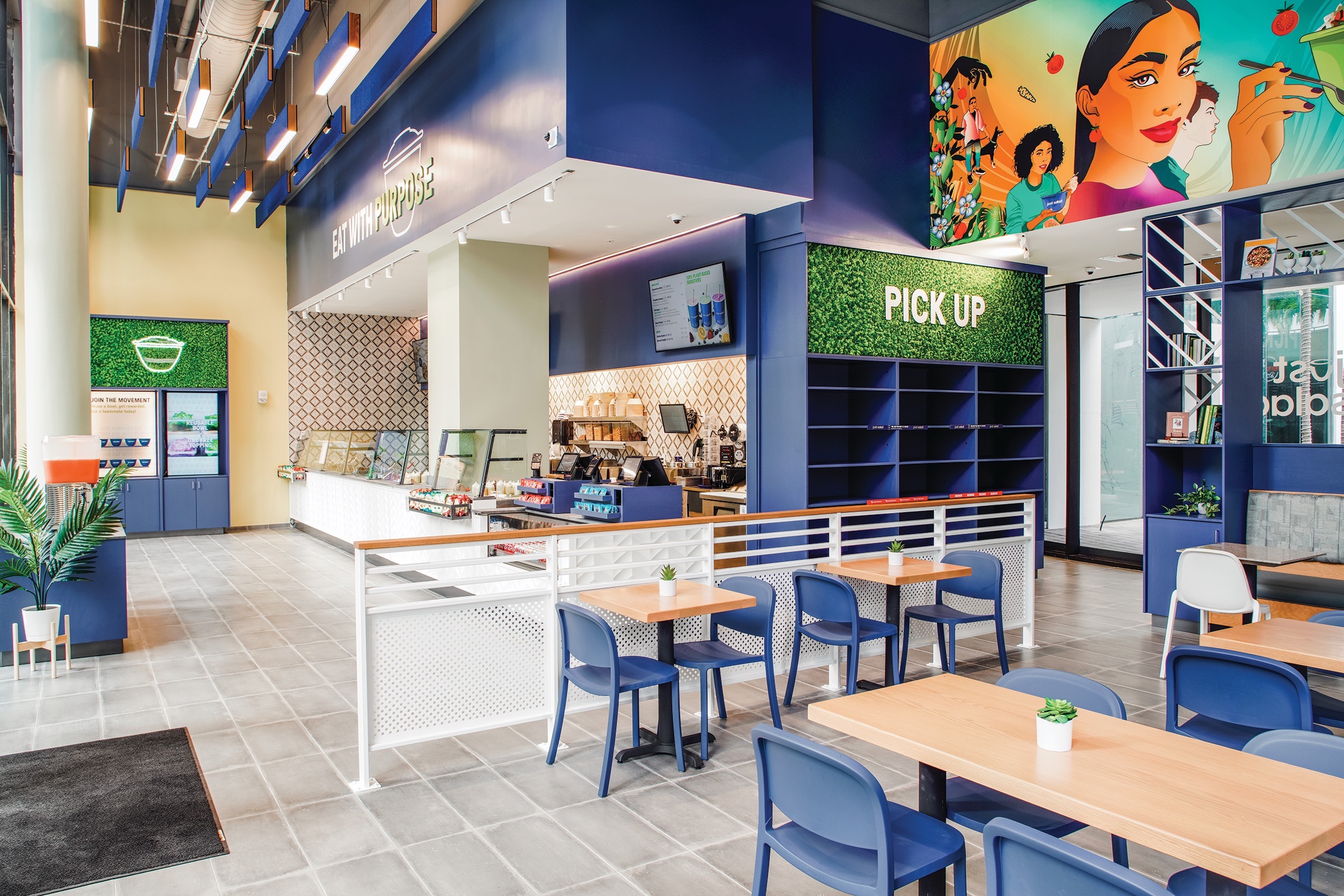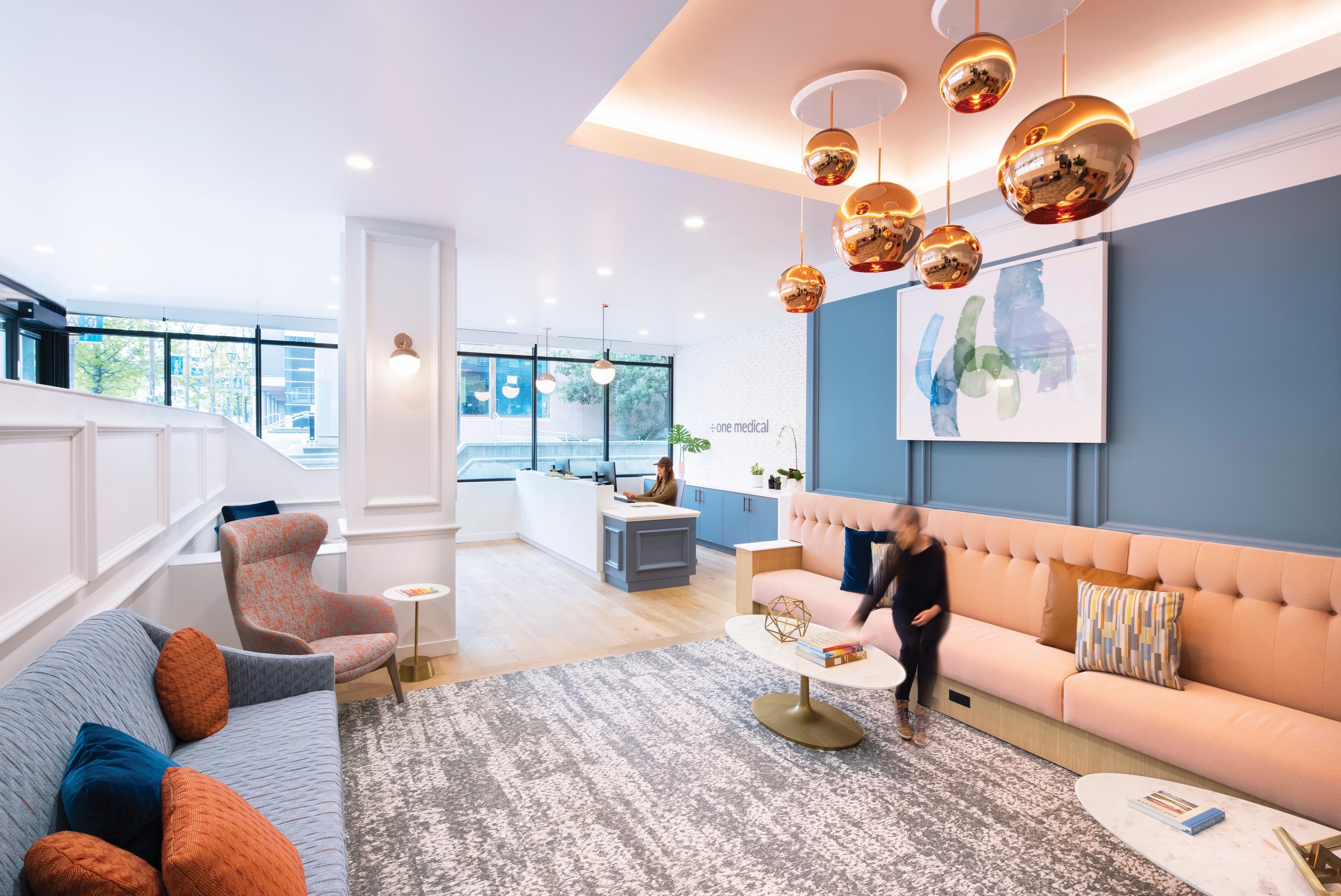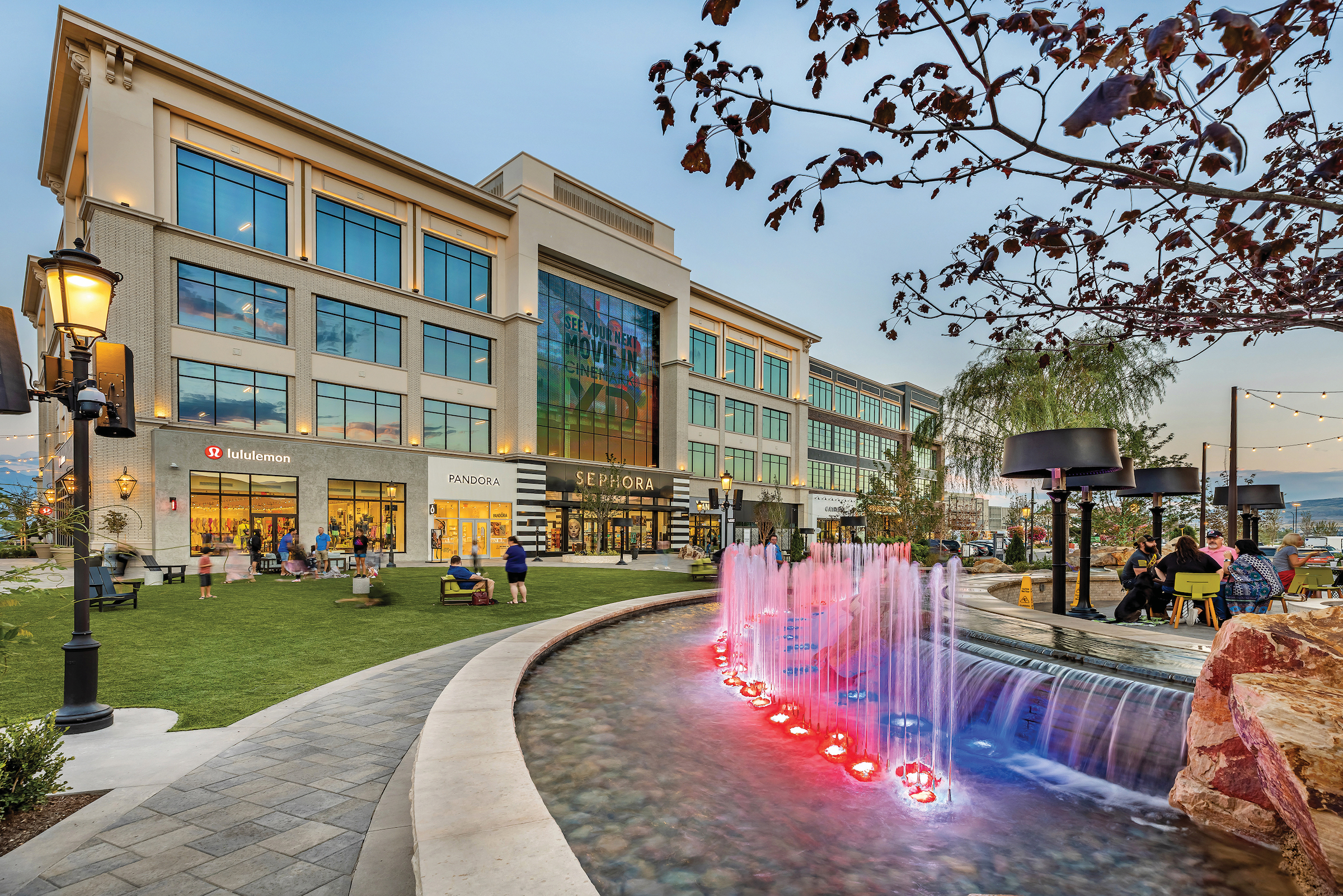Over the past year or so, California-based AO has enjoyed a bump in its retail design assignments that, according to its Managing Partner Rob Budetti, can be attributed mostly to retail being integrated into larger mixed-use projects—one of the leading retail design trends today.
“The mixed-use trend is expanding to more non-traditional elements, incorporating industrial, retail, entertainment, residential into one cohesive development,” he explains. One such example in AO’s portfolio is Phase II of Mountain View Village in South Valley, Utah. AO designed the master plan for this 85-acre destination with more than one million sf of constructed space that includes 30 dining options, a 14-screen Cinemark Theater complex, 177,000 square feet of Class A offices, and shopping options for health and beauty, apparel, home furnishings, and electronics.
The landscaping of Mountain View Village, whose construction was completed in 2022, features thousands of plants and 1,700 new trees. “Our goal was to design and plan a retail concept that replicated a downtown feel with a sense that the buildings were developed over time,” says Budetti.
Retail has also been one of Kimley-Horn’s fastest-growing practice sectors, increasing nearly 80% in 2022, according to Lesley Netzer, the firm’s Director of Retail. Mixed use drove that growth, as traditional shopping malls “are turning into communities offering a combination of apartments, gyms, grocery stores, theaters, retailers, offices, and restaurants.” One of Kimley-Horn’s recent projects, for which it provided civil engineering, due diligence, and permitting services, was The Yard at Fischers District in Indiana, a mixed-use development with multiple restaurants and retail within close proximity. To the east of Fischers District, which was completed last year, Kimley-Horn continues to work on a development called The Stations, which will include a retail pad, a hotel, an office building pad, and 37 townhouses.
Adjusting to seismic disruptions in the retail sector
Retail was as hard hit by the coronavirus pandemic as any corner of the U.S. economy. Simultaneously, retailing was being rattled by the tectonic shift to where online shopping and ordering predominate. These factors alone have made the sector harder to read, even as most of the AEC Giants contacted for this article say their retail practices have been thriving lately.
“On the occupier side of retail, our work has slightly decreased. Our clients are being cautious due to the economy,” says Greg Lang, CBRE’s Senior Managing Director–Retail and Multi-Site sector. However, he adds, his firm has seen an uptick in demand among its investor clients for tenant coordination and real estate development services “for the first time in 2-3 years.”
(Investors and developers continue to send out mixed signals about their interest in retail properties. A few weeks after BD+C interviewed Lang, Pacific Retail Capital Partners acquired the 1.2 million-sf Bridgewater Commons shopping mall in New Jersey, with more than 150 retail tenants. The acquisition included an adjacent 94,000-sf open-air shopping district called The Village at Bridgewater Commons. On the other hand, David Simon, CEO of the mall giant Simon Property Group, told WWD last February that his company wasn’t planning on buying more retailers, at least in the near term.)

Jonathan Fiato, Shawmut Design and Construction’s Senior Director–New York Region, says his firm has also seen an increase in retail-related construction demand, especially among retailers and brands that are investing in their flagship locations. He cites BMW Mini’s Manhattan flagship as one prominent example, as well as Culture Kings’ U.S. flagship, a two-story, 25,000-sf store that opened last November in The Forum Shops at Caesars in Las Vegas. This is Culture Kings’ largest store to date, and features a 75-foot-tall hat wall, arcade machines for patrons, a basketball half court, and a slushy bar. The building team on this project included Henderson Engineers, bokor architecture + interiors, Bunnyfish Studio, and Lighting Design Alliance.
It goes without saying that survival now requires retailers to have a strong and palpable online presence, which includes their physical stores being able to accommodate BOPIS, which stands for “buy online pick up in store.” “Systems need to connect seamlessly to online ordering, inventory, etc., and be easily managed by instore associates,” asserts Michele Devereaux, CPSM, Marketing Strategist for the retail mixed-use practice of Callison RTKL, a division of Arcadis.
While AEC firms report less downsizing of bricks and mortar stores than might be expected, they have been seeing more retailers reducing their in-store inventories in favor of spacious showroom presentations. Retailers “are trending toward right sizing that enhances the omnichannel retail experience,” says Shawn Bland, Core States Group’s Director of Retail. This trend, he adds, has been a boon for his firm’s in-house architectural, engineering, and program management services to help retail clients devise branded, unique brick-and-mortar environments. (Bland points specifically to his firm’s recent work for Primark in Sunrise, Fla., Just Salad in Miami, and the Lidl grocery in Exton, Pa.)
Opportunities for reinvention of retail design
Jason Zoeller, Retail Sector Executive for Henderson Engineers, says that retail clients should always be thinking ahead about how their spaces might need to evolve in the future. He says he’s already seeing a shift toward flexibility about store locations at a time when there’s broad availability of retail space that’s cost effective and offers greater return on investment.
This flexibility is creating opportunities for renovation and adaptive reuse. “We continue to push innovation and develop creative design solutions for clients seeking flexible spaces which can contract and expand based on tenant needs,” says AO’s Budetti.
Lounges in banks and car dealerships are signs of this trend. Other examples find Kimley-Horn helping a nationwide general merchandise retailer upgrade its MEP systems and secure permitting to move refrigeration to the front of its stores. Netzer adds that shopping center developers are collaborating with AEC firms to design interior spaces that appeal to multiple generations, and are ordering landscape architecture for exterior spaces of national restaurants.

To accommodate customers who prefer to order online from their smartphones or cars, quick-service restaurants are building more drive-thrus or mobile-only smaller buildings. (Netzer notes, parenthetically, that these retailers still have the same land needs because the pickup spaces must be larger.)
Retailers are turning to AEC firms when they need to reposition their image with consumers. For example, CallisonRTKL recently helped Petco transform its brand from a big-box pet products store to a health-and-wellness service for pets and their owners. The redesign entailed wider aisles and streamlined wayfinding to make the store easier to navigate. The service design focuses on quality and convenience, and supports every in-store interaction.
Non-retail tenants welcomed
AEC firms say that retail developers and property owner/managers have become more receptive to leasing space to non-retail tenants in shopping plazas and strip malls.
“What’s changed,” explains AO’s Budetti, “is the integration of expanded asset types like multifamily, medical, hospitality, coworking, fulfillment, and larger entertainment venues.” As part of the so-called “Medtail” trend, CallisonRTKL has been assisting One Medical Group, a concierge medical practice, to reposition its spaces as calming, comfortable environments. Since 2017, the firm has provided architectural design and construction administration services for more than a dozen of One Medical Group’s locations that range from 3,000 to 6,000 sf, many of them within retail centers, says Devereaux.
Non-retail tenants sometimes have design and engineering requirements that are different from basic clothing or jewelry stores. “Ventilation, finish treatments, wall assemblies, and lighting are all considerations,” says Devereaux.
AO, says Budetti, has found that upgrades to existing structures are often required to handle larger live loads. Making changes might also mean that zoning needs to be renegotiated. Lang of CBRE says that plumbing is “a major challenge” when converting retail space for non-retail use, especially in older enclosed malls whose infrastructure “never contemplated fitness, education, or medical/dental tenants.” Lang adds that electrical systems in open-air centers typically need upgrades and more capacity. Bland of Core States Group notes as well that accommodating non-retail tenants usually means an increased need for low-voltage design services for technology such as frictionless checkout, POS ordering, and lighting and security controls.
Zoeller of Henderson Engineers suggests that having the right design and construction partners to evaluate a space before leasing is crucial, and often helps when negotiating better leasing terms depending on the upgrades needed.
Related Stories
| Feb 11, 2011
Chicago high-rise mixes condos with classrooms for Art Institute students
The Legacy at Millennium Park is a 72-story, mixed-use complex that rises high above Chicago’s Michigan Avenue. The glass tower, designed by Solomon Cordwell Buenz, is mostly residential, but also includes 41,000 sf of classroom space for the School of the Art Institute of Chicago and another 7,400 sf of retail space. The building’s 355 one-, two-, three-, and four-bedroom condominiums range from 875 sf to 9,300 sf, and there are seven levels of parking. Sky patios on the 15th, 42nd, and 60th floors give owners outdoor access and views of Lake Michigan.
| Feb 11, 2011
Grocery store anchors shopping center in Miami arts/entertainment district
18Biscayne is a 57,200-sf urban retail center being developed in downtown Miami by commercial real estate firm Stiles. Construction on the three-story center is being fast-tracked for completion in early 2012. The project is anchored by a 49,200-sf Publix market with bakery, pharmacy, and café with outdoor seating. An additional 8,000 sf of retail space will front Biscayne Boulevard. The complex is in close proximity to the Adrienne Arsht Center for the Performing Arts, the downtown Miami entertainment district, and the Omni neighborhood, one of the city’s fast-growing residential areas.
| Feb 11, 2011
Apartment complex caters to University of Minnesota students
Twin Cities firm Elness Swenson Graham Architects designed the new Stadium Village Flats, in the University of Minnesota’s East Bank Campus, with students in mind. The $30 million, six-story residential/retail complex will include 120 furnished apartments with fitness rooms and lounges on each floor. More than 5,000 sf of first-floor retail space and two levels of below-ground parking will complete the complex. Opus AE Group Inc., based in Minneapolis, will provide structural engineering services.
| Feb 11, 2011
Green design, white snow at Egyptian desert retail complex
The Mall of Egypt will be a 135,000-sm retail and entertainment complex in Cairo’s modern 6th of October district. The two-story center is divided into three themed zones—The City, which is arranged as a series of streets lined with retail and public spaces; The Desert Valley, which contains upscale department stores, international retailers, and a central courtyard for music and other cultural events; and The Crystal, which will include leisure and entertainment venues, including a cinema and indoor snow park. RTKL is designing the massive complex to LEED Silver standards.
| Jan 25, 2011
AIA reports: Hotels, retail to lead U.S. construction recovery
U.S. nonresidential construction activity will decline this year but recover in 2012, led by hotel and retail sectors, according to a twice-yearly forecast by the American Institute of Architects. Overall nonresidential construction spending is expected to fall by 2% this year before rising by 5% in 2012, adjusted for inflation. The projected decline marks a deteriorating outlook compared to the prior survey in July 2010, when a 2011 recovery was expected.
| Jan 21, 2011
Harlem facility combines social services with retail, office space
Harlem is one of the first neighborhoods in New York City to combine retail with assisted living. The six-story, 50,000-sf building provides assisted living for residents with disabilities and a nonprofit group offering services to minority groups, plus retail and office space.
| Jan 21, 2011
Revamped hotel-turned-condominium building holds on to historic style
The historic 89,000-sf Hotel Stowell in Los Angeles was reincarnated as the El Dorado, a 65-unit loft condominium building with retail and restaurant space. Rockefeller Partners Architects, El Segundo, Calif., aimed to preserve the building’s Gothic-Art Nouveau combination style while updating it for modern living.
| Jan 19, 2011
Baltimore mixed-use development combines working, living, and shopping
The Shoppes at McHenry Row, a $117 million mixed-use complex developed by 28 Walker Associates for downtown Baltimore, will include 65,000 sf of office space, 250 apartments, and two parking garages. The 48,000 sf of main street retail space currently is 65% occupied, with space for small shops and a restaurant remaining.
| Jan 7, 2011
BIM on Target
By using BIM for the design of its new San Clemente, Calif., store, big-box retailer Target has been able to model the entire structural steel package, including joists, in 3D, chopping the timeline for shop drawings from as much as 10 weeks down to an ‘unheard of’ three-and-a-half weeks.
| Jan 7, 2011
Mixed-Use on Steroids
Mixed-use development has been one of the few bright spots in real estate in the last few years. Successful mixed-use projects are almost always located in dense urban or suburban areas, usually close to public transportation. It’s a sign of the times that the residential component tends to be rental rather than for-sale.
















